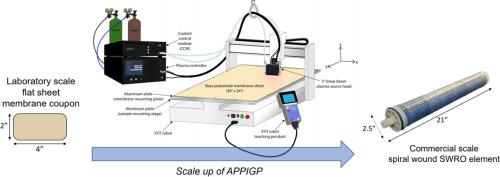Desalination ( IF 8.3 ) Pub Date : 2022-05-20 , DOI: 10.1016/j.desal.2022.115762 Yian Chen , Soomin Kim , Yeunha Kim , Jeremy S. Walker , Tom Wolfe , Kevin Coleman , Yoram Cohen

|
Scale up of atmospheric pressure plasma-induced graft polymerization (APPIGP) was demonstrated for surface nano-structuring (SNS) of a base polyamide (PA) reverse osmosis (RO) membrane with tethered poly(acrylic acid) (PAA) chains. Large SNS-PAA-PA membrane sheets, measuring 76.2 cm × 60.9 cm, were synthesized and used to fabricate small spiral-wound low fouling seawater RO elements (2.5 in. × 21 in.). The SNS-PAA-PA membrane sheets were of high spatial uniformity with respect to both water permeability and salt rejection. Lower SNS-PAA-PA membrane fouling propensity, relative to commercial membranes, was demonstrated in BSA and sodium alginate fouling tests of both membrane coupon and spiral-wound elements. Permeability recovery, upon water flushing of the fouled SNS-PAA-PA spiral-wound membrane elements was complete. Complete permeability recovery was also achieved for the sodium alginate fouled Dow SW30 element upon water flushing; however, permeability recovery was lower (91.6%) for the BSA fouled element, thus suggesting the need for added chemical cleaning. The study results suggest that APPIGP process scale up is feasible for fabrication of commercial-scale low fouling spiral-wound RO elements. However, further scale up toward continuous APPIGP will be required for larger size elements and automated element fabrication should be employed to minimize membrane and element construction imperfections.
中文翻译:

用束缚聚(丙烯酸)对聚酰胺反渗透膜进行表面改性,用于制造低污染的螺旋缠绕元件
大气压等离子体诱导接枝聚合 (APPIGP) 的放大被证明用于具有束缚聚 (丙烯酸) (PAA) 链的基础聚酰胺 (PA) 反渗透 (RO) 膜的表面纳米结构 (SNS)。合成了尺寸为 76.2 cm × 60.9 cm 的大型 SNS-PAA-PA 膜片,用于制造小型螺旋缠绕低污染海水 RO 元件(2.5 in. × 21 in.)。SNS-PAA-PA 膜片在透水性和脱盐性方面具有高度的空间均匀性。与商业膜相比,较低的 SNS-PAA-PA 膜污染倾向在膜试样和螺旋缠绕元件的 BSA 和海藻酸钠污染测试中得到证实。在水冲洗受污染的 SNS-PAA-PA 螺旋缠绕膜元件后,渗透性恢复完成。海藻酸钠污染的 Dow SW30 元件在水冲洗后也实现了完全的渗透性恢复;然而,BSA 污染元件的渗透率恢复较低(91.6%),因此表明需要增加化学清洗。研究结果表明,APPIGP 工艺放大对于制造商业规模的低污染螺旋缠绕 RO 元件是可行的。然而,对于更大尺寸的元件,需要进一步扩大到连续 APPIGP,并且应该采用自动化元件制造来最大限度地减少膜和元件结构的缺陷。研究结果表明,APPIGP 工艺放大对于制造商业规模的低污染螺旋缠绕 RO 元件是可行的。然而,对于更大尺寸的元件,需要进一步扩大到连续 APPIGP,并且应该采用自动化元件制造来最大限度地减少膜和元件结构的缺陷。研究结果表明,APPIGP 工艺放大对于制造商业规模的低污染螺旋缠绕 RO 元件是可行的。然而,对于更大尺寸的元件,需要进一步扩大到连续 APPIGP,并且应该采用自动化元件制造来最大限度地减少膜和元件结构的缺陷。


















































 京公网安备 11010802027423号
京公网安备 11010802027423号